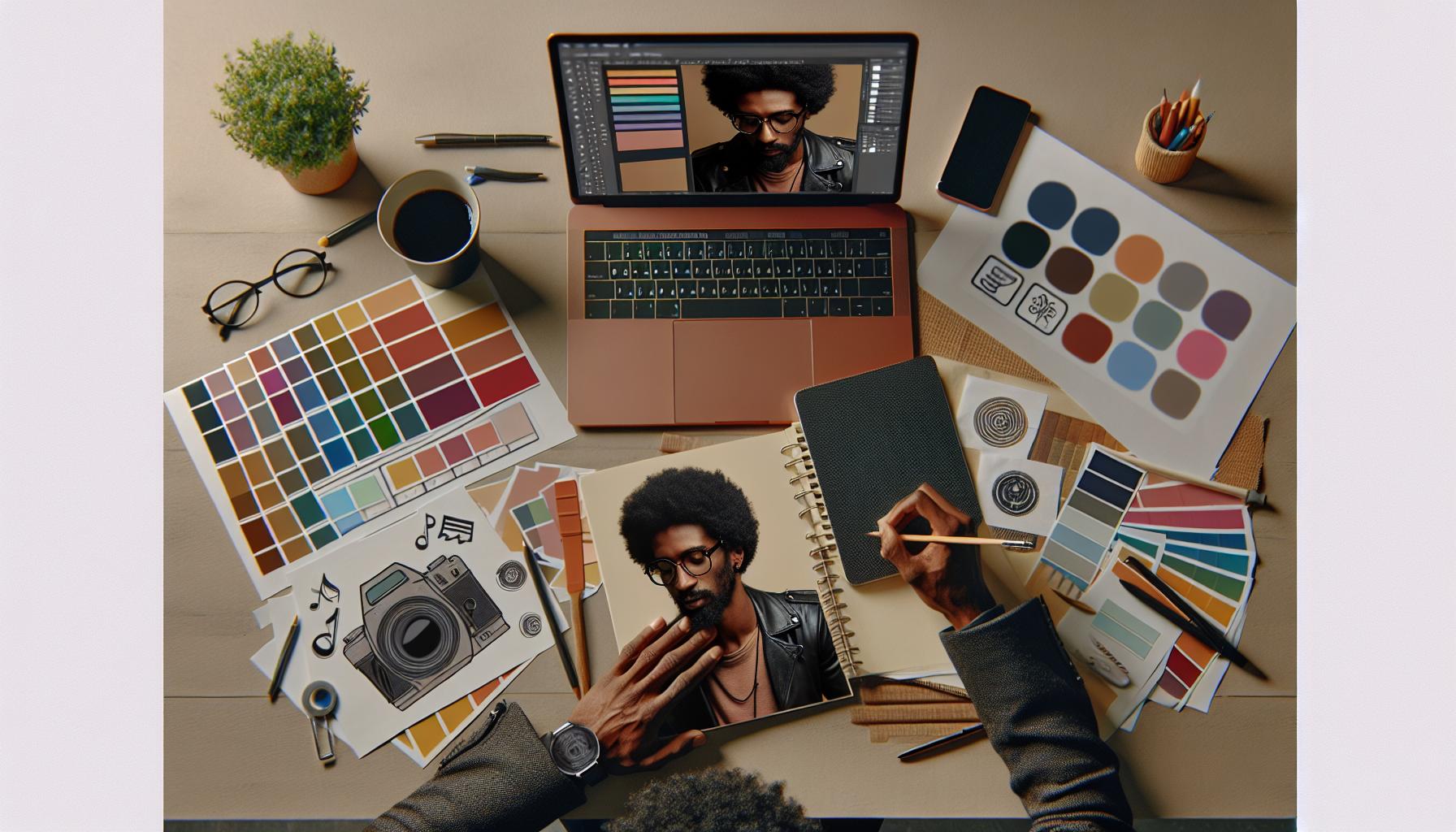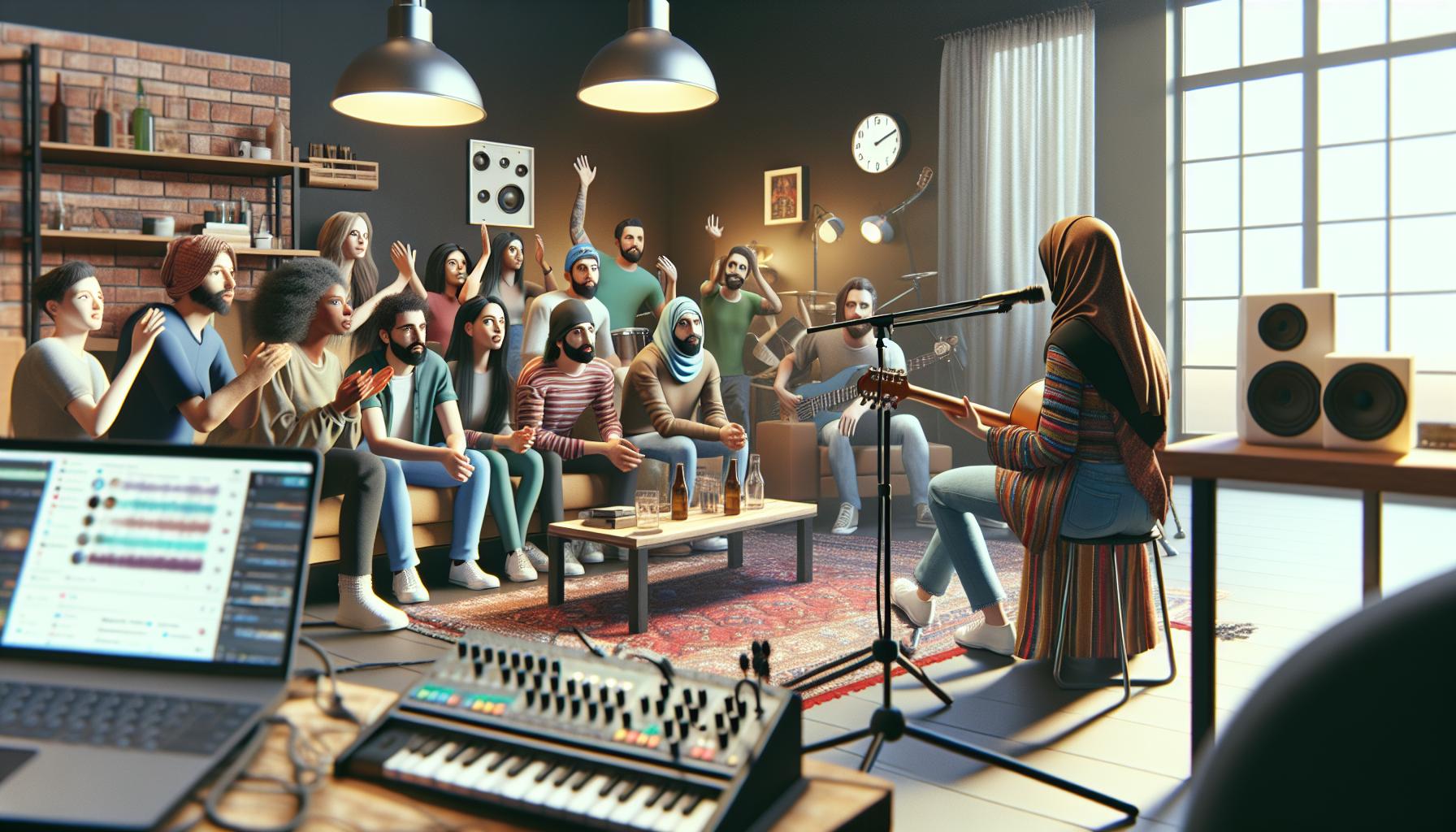In today’s digital age, it’s no secret that social media has become a potent tool for marketing. And for musicians, it’s not just a tool, but a necessity. It’s a platform where they can reach millions of music lovers, promote their work, and build a strong fan base.
But, how can musicians use social media effectively for marketing? What strategies should they adopt? What mistakes should they avoid? If you’re a musician looking for answers to these questions, you’ve come to the right place. In this article, I’ll be sharing my insights and tips on how to leverage social media for music marketing.
Whether you’re an established artist or an emerging talent, understanding the nuances of social media marketing can give you an edge. It’s not just about posting content; it’s about engaging with your audience, understanding their preferences, and creating a brand that resonates with them. Let’s dive in and unravel the secrets of effective social media marketing for musicians.
Contents
Understanding the Importance of Social Media for Musicians
When we talk about marketing in the digital age, it’s impossible to overlook the power of social media. Especially for musicians, social media is a necessity, not an option. But why is it so crucial? Let’s delve into this.
Social media platforms have dramatically evolved over the years. They’re no longer just a place for reconnecting with old friends and sharing photos. They’re now dynamic platforms where news spreads like wildfire and brands gain massive exposure. For musicians, social media serves as a platform to reach millions of music lovers worldwide.
Being present on platforms like Instagram, Twitter, Facebook, and Youtube, allows musicians to display their work, promote new music, keep fans updated, and even sell tickets to shows. It’s an innovative, cost-effective way to promote one’s work and produce a substantial impact with minimal resources.
But it’s not just about sharing and promoting work. Social media provides opportunities to interact directly with fans. You can engage in meaningful dialogues, build relationships, and strengthen your fanbase. In our digital world, this connection with fans goes a long way in building a strong, loyal fan base.
Recognizing fan preferences is a brilliant bonus of social media marketing. You can track which posts are well-received, which songs are fan favorites, and how fans react to different types of content. This invaluable data can help steer your creative decisions and ensure your brand resonates with your audience.
Social media for musicians is all about creating a compelling presence and nurturing an engaged community of listeners. By understanding the power of social media, musicians can adapt their marketing strategies and flourish in our digital world. Remember, a strong social media presence isn’t just a marketing asset – it’s a valuable part of your brand.
Setting Your Goals and Target Audience

When you’re applying social media marketing strategies to promote your music, it’s critical to first determine your key goals and who your target audience is. Identifying your objectives and knowing your potential listeners greatly informs your approach to social media platforms.
It’s no secret that goals provide direction. We’re talking about S.M.A.R.T (Specific, Measurable, Achievable, Relevant, Time-bound) goals here. For instance, you might aim to release a new album or single and hope to achieve a certain number of streams on Spotify within a certain timeframe. Or perhaps you’re looking to sell a set number of tickets for an upcoming gig. Whatever your objectives, be specific. It’s easy to say, “I want more followers”, but it’s more impactful when you define exactly what ‘more’ means.
Although it’s critical to have goals, knowing who you’re targeting is equally vital. You don’t want to be a talented musician playing to an empty room. Understanding your audience involves studying demographics, behavior, preferences, engagement patterns, and more. It seems like a lot, but trust me, it’s crucial for a successful marketing campaign.
Platforms like Facebook and Instagram provide excellent tools for audience analysis. You can dive into the User Insights feature to learn more about your followers: their age, gender, location, the times they’re most active, and more. Also, the platform Twitter, accessible via its Analytics dashboard, provides a comprehensive summary of your followers’ interests, which can be a goldmine for musicians seeking to optimize their content.
Taking the time to fine-tune your target audience enhances your overall social media strategy and allows you to achieve your goals much more effectively. You’re not just randomly playing your music; you’re deliberately holding a concert for the fans who truly appreciate and resonate with your sound. It’s a win-win situation.
You might wonder if setting goals and determining a target audience feel too business-like and less about the art. I want to assure you that it’s about striking a balance. Yes, music is at the heart, but understanding these factors catapults your chances of getting your art to the right ears. So, in essence, it’s music marketing done right.
Crafting Your Brand Identity

Laying the groundwork for an effective social media marketing campaign for your music means crafting your brand identity. Brand identity isn’t just picking a logo or choosing the right selfie for your profile picture. Although these elements contribute, they’re merely parts of the complex identity puzzle. Here’s my take on how you can approach crafting a compelling brand identity.
Clear Message and Consistent Aesthetic
It’s all about presenting a united front across all your platforms. Whether it’s Instagram, Facebook, or Twitter, your message should be clear and your aesthetic should be consistent. You’re establishing a brand, which is essentially your music’s visual and philosophical identity. This consistency extends to the tone and voice you use in your posts and responses. It should reflect your artistic persona and resonate with your fans.
Engaging Story
People get riveted by good tales. So inject a narrative into your brand! Where did you start? What’s your passion? What drives you? An engaging story can transform prospective listeners into staunch fans. And remember, honesty and authenticity go a long way here. People respond to genuine emotions and stories.
Purpose and Values
What do you stand for? What’s your mission in the music industry? Your purpose and values should shine through every interaction, from your music, posts, to your responses. Don’t just talk about it, make sure it’s reflected in your actions. Stand for something and communicate it effectively.
Visual Identity
Lastly, an integral part of your brand identity is your visual identity. This is where you think about logos, color palettes, typography, and imagery. Your visuals are often the first thing people see, make sure they embody your music and what it stands for.
Through these, bear in mind, every piece contributes to your overall brand identity. You can convey ethos, captivate audiences, and foster a deep connection that goes beyond just your music. Crafting your brand identity is like setting the stage, it’s your gateway to forming meaningful relationships with your fans.
Building an Engaged and Loyal Fan Base

After we’ve established a solid brand identity, the next step is to build an engaged and loyal fan base. This isn’t about amassing a large number of followers, but connecting with enthusiasts who genuinely appreciate and support your music.
To create an engaged fan base, consistent and meaningful interaction is critical. It’s more than just announcing releases or concerts. It’s about facilitating an open line of communication and building rapport with your audience.
There are countless ways to accomplish this, such as:
- Sharing behind-the-scenes videos or photos
- Responding to comments and messages promptly
- Hosting live sessions or Q&As
The idea is to show fans that there is a real person behind the music they love.
But how do we build a loyal base? The answer lies in value exchange. Provide your followers something beyond your music. This could come in various forms, such as exclusive content or merchandise, opportunities for direct communication, or even chances for them to be involved in your creative process.
Here’s a quick guide on how to create value for your fans:
- Understand their wants and needs
- Treat them with respect and appreciation
- Offer unique experiences or goods tied to your brand
Doing so not only cultivates loyalty but enhances your brand’s overall value. By giving your fans an experience unique to your brand, you leave an unforgettable mark, one that specifically attaches to your music.
Creating Compelling Content

Engaging your fans is paramount but producing engaging content is the powerhouse that propels that engine of engagement. Compelling content is the key to not just having but maintaining an engaged and loyal fan base. It isn’t just about releasing songs or albums – it’s creating a body of work that resonates with people.
Interested in how to create such content? I’ve got you covered.
First, scenarios related to your music give your fans insight into your creative process. For instance, behind-the-scenes videos of an album recording process or writing sessions. There’s a behind-the-scenes nugget for everybody – from guitar enthusiasts who’d love to see a breakdown of your guitar rig to budding lyricists who might appreciate understand the meaning behind your lyrics.
A more engaging content example is organizing Live Q&A sessions. Your fans would have the opportunity to discuss everything from your music to your experiences. They’re interactive. They’re engaging. They’re real. What more could a fan ask for?
We can’t forget exclusive content. Fans appreciate originality and exclusivity. Consider setting up a membership plan where fans get first dibs on new songs, videos, merchandise, or ticket sales.
And then there’s merchandise. It’s not just about albums and concerts anymore – fans want to feel a part of the journey. Merchandise that has some tie-in with your music – from vinyl to t-shirts to action figures – not only provides an additional revenue stream but also more importantly a physical connection between you and your fans.
Remember that the most compelling content needs to be authentic and valuable to your fans. Make sure they know that they are a part of your musical journey, not just spectators.
Leveraging Different Social Media Platforms
You know as well as I do that social media is not a one-size-fits-all market. Different platforms bring different audiences and a unique feel. In the vast ocean of apps and websites, I’ll focus on the must-haves: Facebook, Instagram, Twitter, and TikTok.
Don’t knock out the old workhorse just yet. With well over 2.8 billion monthly active users, Facebook still packs a punch. It’s a crucial platform for older demographics and allows targeting vast audience groups. Yet, the biggest win is Facebook Live, where you can host those intimate Q&A sessions or live shows, creating an interactive experience with your fans.
If Facebook is the solid workhorse, then Instagram is the fiery stallion. It’s all about visuals and aesthetics. It’s the perfect platform to share those behind-the-scenes glimpses and merchandise images. With over 1 billion monthly active users, you cannot afford to miss the Instagram bandwagon.
Twitter is a platform with a more sophisticated audience. It’s an excellent place for quick updates, thoughts, or announcements. Twitter allows for lively interactions and chances to go viral with moments or hashtag campaigns.
TikTok
The newest kid on the block, TikTok, has taken the world, and especially the younger audience, by storm. TikTok’s short-form video content is a different ball game altogether. It’s an ideal platform for musicians to showcase their creativity, innovation, and personality.
Each platform offers specific options for musicians in marketing themselves. It’s worth utilizing every avenue to reach your fan base. Don’t forget to stay authentic to your style and engage regularly to keep your fans interested.
Analyzing and Improving Your Social Media Performance

To make the most of your music marketing campaigns, it’s crucial to monitor the performance of your social media efforts continually. Every platform, whether it’s Facebook, Instagram, Twitter, or TikTok, provides extensive analytics. And it’s this data that’s your key to refining your strategy and achieving success.
Understanding these metrics can feel overwhelming at first. Let’s focus on the ones that really matter to us as musicians.
- Engagement Rates: This includes likes, comments, shares, retweets, and any other form of interaction with your posts. A high engagement rate means your content resonates with your audience.
- Follower Growth: Check every week or so to see if your follower count is increasing, decreasing, or stagnant. This will inform you if your content appeals to a wider audience or needs tweaking.
- Reach and Impressions: It’s crucial to know how many people are seeing your posts and how often. Reach demonstrates the number of unique users who saw your content, while impressions indicate multiple views from a single person.
- Click-through Rates (CTR): CTR measures the percentage of viewers who clicked on your call-to-action or link across your posts. This gives you insight into how effective your content is at encouraging your audience to take the desired action.
The collected data should be compared over time to track performance and identify trends. This is often represented in a table. The table may appear as follows:
| Metrics | Week 1 | Week 2 | Week 3 | Week 4 |
|---|---|---|---|---|
| Engagement Rate | 3.5% | 4.2% | 4.8% | 4.6% |
| Follower Growth | 100 | 150 | 200 | 170 |
| Reach | 2500 | 2700 | 3000 | 3100 |
| Impressions | 3000 | 3300 | 3600 | 3500 |
| CTR | 2.0% | 2.5% | 3.0% | 2.7% |
Remember, the objective here isn’t to get obsessed over numbers, but rather to gain insights to tweak your strategy. Social media is a trial-and-error platform where you can experiment freely. See what works best for your genre of music and audience, and keep refining your approach accordingly.
Avoiding Common Social Media Marketing Mistakes
For musicians, social media marketing is a powerful tool when executed correctly. It’s essential to avoid common mistakes that can hinder your growth and engagement stats. Music marketing strategies aren’t one-size-fits-all, but these are pitfalls I’ve seen artists stumble into time and time again.
One major error artists make is not having a consistent posting schedule. It’s vital to maintain regular content flow to keep your audience engaged. Frequency is a fine balance – you don’t want to oversaturate your followers with content, but you also can’t afford long radio silences.
Underestimating the Importance of Interactive Content
Creating compelling, interactive content is another key area where musicians can often fall short. Live videos, Q&A sessions, Instagram stories, interesting behind-the-scenes snapshots – these aren’t add-ons – they’re crucial to your marketing strategy’s success.
Another common blunder is not tracking metrics over time. As mentioned earlier, monitoring engagement rates and other key metrics isn’t a one-time activity. It’s a constant effort that should be part of your day-to-day routine. When you’re not measuring your results, you’re shooting in the dark.
Sticking to one platform is another error many musicians tend to make. Different platforms will yield different results, so a multi-platform approach is beneficial. Allocate resources wisely – you don’t need to be everywhere, just where your audience is.
Let’s not forget about the importance of a customized approach. Trying to mimic the strategy of another successful artist can lead to failure. Remember, what works for one person might not work for another. Your marketing strategy should be unique, reflecting your music, and your personality.
And then there’s neglecting to utilize ads. Social media advertising tools are powerful boosters for your content’s reach. Ignoring these tools is like leaving money on the table, so make sure to invest wisely.
In the next section, we’ll dive deeper into the benefits of social media advertising for musicians, and how to make the most of these tools. Stay tuned.
Conclusion
Social media marketing is a powerful tool for musicians. It’s clear that a strategic, tailored approach can make all the difference. Consistency, interactive content, and tracking metrics are non-negotiables. Sticking to one platform won’t cut it, and the potential of social media advertising tools is too great to ignore. As musicians, it’s crucial we steer clear of these common pitfalls. Armed with the insights from this article, we’re equipped to truly harness the power of social media for our music marketing needs. Let’s put these lessons into practice and watch our audience grow.
